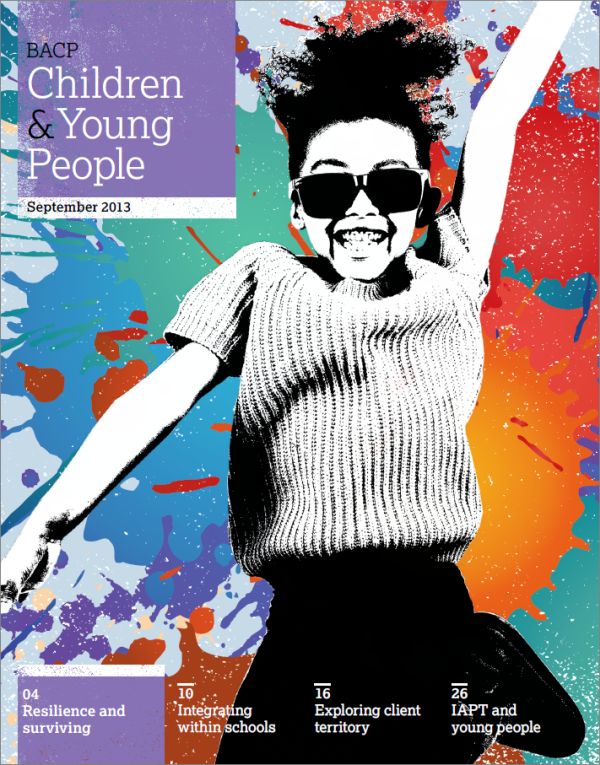In this issue
Features
Surviving sexual abuse
Aqualma Murray’s keynote speech from our June conference
Integrated and focused
CYP interviews Benita Refson, CEO of the charity Place2Be, which has recently attracted royal patronage
Cultural mosaic
Hazel McClure explores essential information for counselling third-culture children, here or abroad
In practice
Sticky bubbles, stats and Snap (free article)
Strategies for safely exploring the territory of self-harming clients, by Edith Bell
Phototherapy
Del Loewenthal demonstrates the use of his Talking Pictures Therapy
Respond
A London agency working with a relational and attachment-based systems model. Report by James Hawkins
Issues
MindFull emerges online
Lalage Harries explains a new resource for young people
IAPT and young people
Helen Hardacre presents a personal view of the emerging continuum of working in an adult IAPT service with young people
Counselling MindEd update
Questionnaire results and scoping reports
Regulars
Reflecting on… what I do
Jeanine Connor
Thinking about… offering information
New columnist Julie Fallon
Considering… effective writing about clients
New columnist Nick Luxmoore
From the chair and updates

Not all articles from this issue are available online. Divisional members and subscribers can download the pdf from the BACP Children and Young People archive.
Welcome from the editor
I wonder how many of us watch TV programmes related to our profession? Or do we prefer to switch off (literally) out of hours? I vacillated too long and so ended up watching Don’t Call Me Crazy (shown on BBC3 in June and July and dealing with inpatients at a teenager mental health unit) on iPlayer. This was a happy result, since the television would have brought the images pretty much full size into my living room, whereas the iPad allowed me to keep them tiny and contained. Why the distinction? Because I feel under ‘YP information attack’ on all sides these days and self-care means I need to be wary, even though professional development says ‘watch’.
The programmes were informative and thought-provoking – so many worsening mental health problems in the young, and so many escalated from commonplace stress factors. I wondered why those young people had had no early access to ‘normal’ counselling. We saw nothing done there that could not have been done earlier elsewhere, good as the staff were, and before suicide ideation walked through the door. Which is why I am pleased to look at four services in this issue, and especially delighted to interview Benita Refson about Place2Be and the charity’s nearly 20 years of work in schools. This is where the help has to start – with supporting parents, with educating teachers about mental health, and with containment and alleviation of children’s and young people’s distress before they get to the psychiatric unit stage. However, out in the community, Helen Hardacre introduces us to the plate-spinning of merging a YP counselling service into the Primary Intermediate Mental Health Team, where only some of the clients hit the age threshold for IAPT work, and James Hawkins writes about the model used at Respond – for vulnerable youngsters in schools, community hubs and at a clinic. Online, we also see the launch of MindFull, an accessible mental health site for teens to find mentoring, support and counselling. It seems we are doing our best to forestall a worsening situation!
Back in the nitty-gritty of our everyday client work, Edith Bell offers excellent practical strategies and thoughts on exploring the territory with self-harming clients. This is based on a workshop she offered at the recent CYP conference. Also at the conference was Aqualma Murray. Her opening keynote had us alternately laughing and stunned into pin-drop silence. In an unusual move (for such a well-edited journal!), I have merely transcribed her keynote and shrunk it to fit, but otherwise left her words as they were delivered, live. This was an aural experience for the listeners and it needs to be ‘heard’ – just like the young people we work with need to be heard and held in hope when they too have survived sexual abuse. I was moved to listen and I hope you will be moved to ‘hear’ as you read.
I have commissioned two more columnists so that we can have a veritable smorgasbord of short, focused pieces. Jeanine Connor has reflected for us for two years now, and is based in Tier 3 CAMHS. She is joined by Julie Fallon, who has written for us at greater length in the past and will focus on supervision thoughts, and by Nick Luxmoore, who is school-based as he offers his considerations. These are the iPad screenings in the journal. Tiny and contained. More tweet than blog. Hopefully this new variety of content will help us all not to switch off after hours but maintain our interest and energy.
Eleanor Patrick
Editor
